|
|
|
Sort Order |
|
|
|
Items / Page
|
|
|
|
|
|
|
| Srl | Item |
| 1 |
ID:
118734
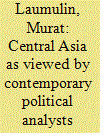

|
|
|
|
|
| Publication |
2012.
|
| Summary/Abstract |
Not so long ago it seemed that by the end of the 2000s interest in Central Asia from abroad had exhausted itself and there was nothing new to add to what had already been written about the region. The West, which paid the greatest attention to the region due to the presence of America and NATO in Afghanistan, appeared to have lost its geopolitical interest in Central Asia. Washington unofficially recognized Russia's "legitimate" interests in the region as part of the reset policy, probably in the hope that Moscow's influence would be trimmed by China's increasing presence in the same region.
|
|
|
|
|
|
|
|
|
|
|
|
|
|
|
|
| 2 |
ID:
186604
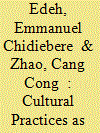

|
|
|
|
|
| Summary/Abstract |
China’s One Belt One Road (OBOR) centres on building a harmonious world, by reorienting the already tumultuous international community, towards the path of sustainable, peaceful and harmonious coexistence. From a cultural perspective, the OBOR is a heritage, an embodiment of brilliant civilization, glorious historic past and extraordinary creativity of mankind. It harbours both tangible and intangible representations of the values, beliefs, traditions and lifestyles of prior generations that are valuable to the present generations. Evidence of historical socioeconomic development and intricacies thrived on the exchange of cultural values shared by all mankind. By drawing from diverse conceptual frameworks embedded in traditional Chinese cultural values, the study offers an insightful illustration of cultural practices in contemporary China’s socioeconomic development through the OBOR. Capturing how cultural values underpins the socioeconomic development pattern in OBOR, geopolitical decisions and actions aimed at managing conflicts and the inclusive nature of OBOR.
|
|
|
|
|
|
|
|
|
|
|
|
|
|
|
|
| 3 |
ID:
157658
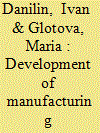

|
|
|
|
|
| Summary/Abstract |
The slowdown in China's economic growth rates has confronted Beijing with the problem of comprehensively modernizing its technological ways and means of production, including the introduction of industrial robots and systems for automatization. This work attempts to analyze the prospects for and effectiveness of current policy, along with its long-range consequences (including its socioeconomic dimensions) in light of the breakthrough potential of robo-technology.
|
|
|
|
|
|
|
|
|
|
|
|
|
|
|
|
| 4 |
ID:
050915
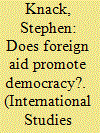

|
|
|
| 5 |
ID:
124936


|
|
|
|
|
| Publication |
2013.
|
| Summary/Abstract |
The contestation and appropriation of water is not new, but it has been highlighted by recent global debates on land grabbing. Water grabbing takes place in a field that is locally and globally plural-legal. Formal law has been fostering both land and water grabs but formal water and land management have been separated from each other-an institutional void that makes encroachment even easier. Ambiguous processes of global water and land governance have increased local-level uncertainties and complexities that powerful players can navigate, making them into mechanisms of exclusion of poor and marginalised people. As in formal land management corporate influence has grown. For less powerful players resolving ambiguities in conflicting regulatory frameworks may require tipping the balance towards the most congenial. Yet, compared with land governance, global water governance is less contested from an equity and water justice perspective, even though land is fixed, while water is fluid and part of the hydrological cycle; therefore water grabbing potentially affects greater numbers of diverse water users. Water grabbing can be a powerful entry point for the contestation needed to build counterweights to the neoliberal, corporate business-led convergence in global resource governance discourses and processes. Elaborating a human right to water in response to water grabbing is urgently needed.
|
|
|
|
|
|
|
|
|
|
|
|
|
|
|
|
| 6 |
ID:
123008
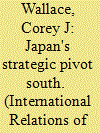

|
|
|
|
|
| Publication |
2013.
|
| Summary/Abstract |
Tensions between Japan and its neighbors pose a significant problem for the viability of Japan's strategic 'dual hedge' between China and the United States. Japan's response has been to embrace renewed US commitment to the region while initiating comprehensive strategic partnerships in military, economic, and political spheres with nations 'south' of its traditional domain of strategic interest. Strengthened relationships with Southeast Asian nations, India, and Australia may turn out to be crucial for Japan as it will enable Japan to manage its security affairs without having to depart from its long-cultivated maritime security policy, and will enable Japan to continue to pursue a neo-mercantilist economic policy while also supporting the socioeconomic development of other regional players essential for future multipolar balance. Japan's diplomatic activities provide a useful 'strategic contrast' with China that will likely ensure Japan is accepted in the region. Japan's strategic pivot is also domestically sustainable and, therefore, deserves scholarly attention.
|
|
|
|
|
|
|
|
|
|
|
|
|
|
|
|
| 7 |
ID:
132740
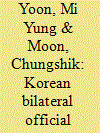

|
|
|
|
|
| Publication |
2014.
|
| Summary/Abstract |
In the past several years, the Republic of Korea-a former least developed country (LDC) and aid recipient that became a donor-joined the "club of emerging donors" to Africa. In March 2006, President Roh Moohyun declared Korea's Initiative for Africa's Development. The initiative puts poverty reduction and socioeconomic development of African countries in the forefront. Using pooled cross-sectional time series data, in this study we examine the determinants of Korean bilateral official development assistance (ODA) to Africa for the period 1991-2011. The findings of the study suggest that the approach of Korean ODA does not differ significantly from that of many conventional donors whose ODA disbursement has had a dual purpose: to improve the welfare of developing countries and to serve self-interests.
|
|
|
|
|
|
|
|
|
|
|
|
|
|
|
|
| 8 |
ID:
090975
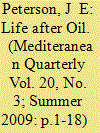

|
|
|
|
|
| Publication |
2009.
|
| Summary/Abstract |
There have been three economic transformations of the Arab Gulf. Yet the obstacles today remain eerily similar to those of forty years ago. Oil reserves are finite and nonoil resources in the gulf states-minerals, arable land, skilled population, and even capital for some countries-are scarce. Thus the path to economic diversification is especially difficult. While half of the six Gulf Cooperation Council countries enjoy sizable surplus income at present, the other three face immediate requirements for replacing oil income. The various strategies chosen to prepare for a viable economic future differ according to the group, and the task is further complicated by authoritarian regimes and inefficient state planning.
|
|
|
|
|
|
|
|
|
|
|
|
|
|
|
|
| 9 |
ID:
096065


|
|
|
| 10 |
ID:
124895
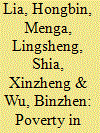

|
|
|
|
|
| Publication |
2013.
|
| Summary/Abstract |
We use the Chinese College Student Survey, conducted in 2010, to examine levels of poverty among students on China's campuses. With the poverty line defined as the college-specific expenditures a student needs to maintain a basic living standard on campus, we find that 22 per cent of college students in China are living in poverty. Poverty is more severe among students from rural or western parts of the country. With a targeting count error of more than 50 per cent, it is important that the college need-based aid programme be improved. Lacking other income sources, poor students rely heavily on loans and paid employment to finance their college education.
|
|
|
|
|
|
|
|
|
|
|
|
|
|
|
|
| 11 |
ID:
159771


|
|
|
|
|
| Summary/Abstract |
The ravines found along the Chambal River are among the most severe types of gully erosion found in semi-arid India. This paper estimates the extent and areal expansion of ravines over 40 years in the Lower Chambal Valley and provides a classification scheme to understand ravine characteristics in the region. To examine the implications of ravines on socioeconomic development and livelihoods of the people in the area, a mixed method approach has been followed. A combination of spatial and statistical tests has been run to examine the overall status of land degradation and its impact in the area concerned. Village-level socioeconomic data have been integrated with physical and environmental parameters in a GIS environment, which has been supplemented with findings from a qualitative survey in a few villages of the study region. The results show that there is a positive and significant relationship between indices of natural resources availability and socioeconomic development. A majority of villages within ravines were found to be very poor in development. In this fragile environment, people’s livelihoods are being adversely affected because of land degradation.
|
|
|
|
|
|
|
|
|
|
|
|
|
|
|
|
| 12 |
ID:
105395


|
|
|
|
|
| Publication |
2011.
|
| Summary/Abstract |
This article investigates the relation between socioeconomic development and democratization in contemporary Turkey with reference to modernization theory. Based on studies showing that there is a positive correlation between socioeconomic modernization and democratization, it is argued that the relatively increased level of socioeconomic modernization in contemporary Turkey has created a more conducive environment for further democratization and democratic consolidation. In this regard, Turkey's GDP per capita, income distribution (Gini coefficient), level of industrialization and urbanization, educational attainment, and human development index (HDI) are analyzed in terms of their influence on democratization. Taking into account Turkey's increased level of socioeconomic development, EU-based reforms, and recent Freedom House ratings, it is argued that Turkey could be getting closer to democratic consolidation.
|
|
|
|
|
|
|
|
|
|
|
|
|
|
|
|
| 13 |
ID:
147751
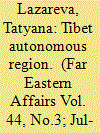

|
|
|
|
|
| Summary/Abstract |
The author describes rapid social and economic processes going on in the Tibet Autonomous Region of China. The development of the region covers all aspects of vital activity: politics, the economy, social sphere, culture, education, medicine, construction of the infrastructure, transportation system, etc. She also examines factors of instability in the development of autonomous regions.
|
|
|
|
|
|
|
|
|
|
|
|
|
|
|
|
| 14 |
ID:
060211


|
|
|
|
|
| Publication |
Boulder, Lynne Rienner Publishers, 2005.
|
| Description |
xi, 333p.: tables, figureshbk
|
| Series |
Middle East in the International System
|
| Standard Number |
158826274X
|
|
|
|
|
|
|
|
|
|
|
|
Copies: C:1/I:0,R:0,Q:0
Circulation
| Accession# | Call# | Current Location | Status | Policy | Location |
| 049435 | 953.57/DAV 049435 | Main | On Shelf | General | |
|
|
|
|
|
|
|
|
|